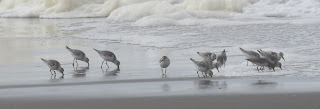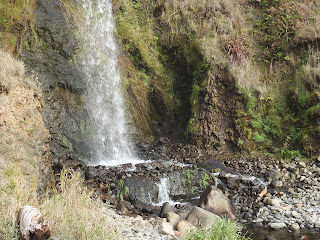Rain was predicted to arrive so I took the first chance when weather and tides aligned for me to do my monthly beached bird survey at Bob Straub Park. My plan was to go from there to Short Beach to look for Black Oystercatchres and see if the subadults I had seen there earlier were still around and still looking like subadults. I thought if I checked every month after my beached bird survey, I would be able to figure out when they attained full red bills and red eyes like the adults. Good plan. Hasn't worked so far. But the trip was a great success anyway.
The weather was beautiful and dead birds few at Bob Straub. Live birds were more interesting than usual, I learned after photographing them and putting them on the computer later. This trio consists of one adult Sanderling and one juvenile Sanderling with pretty scalloped back AND one Snowy Plover... only the second one I've ever seen at Bob Straub Park. But that may be more an indication of me not photographing and then blowing up on the computer every plover I see. I have been assuming they are Semi-palmated Plovers and most probably are. I'll look closer after this.
I also took a very long distance photo of Sanderlings running along the beach, as they usually do. But when I zoomed my photo in, one bird was darker and bigger than the others. I sent the photo to my shorebird identifier friend, Paul Sullivan, who thinks it is a Dunlin. They are not particularly rare but, again, I have not noticed them at this beach. Who knows what else I've been missing.
 |
| The one Dunlin is far right foreground |
The beach is ever changing. The beach grass is colonizing the area that used to be the wood zone, now mostly covered with sand.
I only found one dead bird to measure, identify and tag. The hike still took three hours. Then I drove north to Short Beach to look for Black Oystercatchers. I did find a few but the only ones I saw well enough in the misty late afternoon light to identify were adults. Most looked like this:
But the rocks off Oceanside were lovely.
To avoid the bathing gulls, in hopes Oystercatchers would join them, I walked high on the beach over big round rocks at the base of the cliff, a place I seldom go because it's so hard walking. To my amazement there was one plant being devoured by beautiful caterpillars. I later learned that they will turn into Anise Butterflies. I also learned that there are different stages of caterpillars. The smaller black ones in my photos are a younger stage than the spectacular gold and black ones. I saw two of the smaller ones, that I dubbed Halloween caterpillars, and ten of the big and beautiful ones. They were devouring this one plant, which I later learned is an Angelica lucida, seacoast angelica, and a host plant for these butterflies. Thanks to friend Mary for the research!
 |
| Seacoast Angelica covered with caterpillars |
This still looks like a spooky Halloween caterpillar to me!
The seacoast angelica and its caterpillars were very close to the waterfall that tumbles from a wooded flume high above the beach. I presume the bush is far enough from the usual high tides to keep from washing away its inhabitants. I'll have to go again each month this winter to find out! And look for Black Oystercatchers... What a lovely excuse to visit Short Beach.










No comments:
Post a Comment